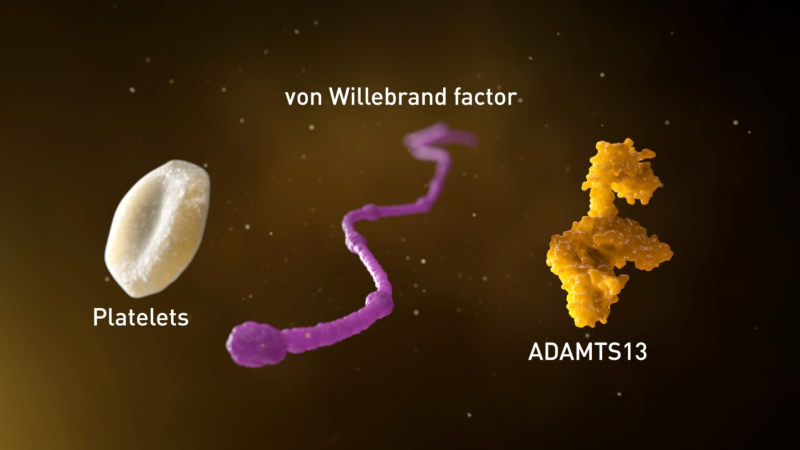Informationen på denna sida är på engelska.
Congenital thrombotic thrombocytopenic purpura (cTTP) is an ultra-rare thrombomicroangiopathy caused by an inherited deficiency of the VWF (von Willebrand Factor) cleaving metalloprotease, ADAMTS13, resulting in the abnormal presence of ultra-large VWF multimers and the formation of circulating platelet rich microthrombi. 1 1. Alwan F, et al. Blood. 2019;133(15):1644–1651.
The clinical presentation ranges from life-threatening, acute, overt TTP events to milder TTP manifestations, including thrombocytopenia, haemolytic anaemia, abdominal pain, headaches and neurological symptoms. End-organ damage due to recurrent overt and nonovert TTP, such as stroke, chronic kidney disease, or cardiac involvement, can also develop. 2 2. Scully M, et al. N Engl J Med. 2024;390(17):1584-1596.

There are two main types of TTP: 3 3. Sakai K, et al. J Thromb Haemost. 2020;18(11):2929-2941.
- The majority of TTP cases are the acquired type and are caused by anti-ADAMTS13 autoantibodies (immune-mediated TTP).
- The remaining cases, which are extremely rare, are congenital TTP (cTTP), also known as Upshaw-Schulman syndrome, and are caused by mutations in the ADAMTS13 gene.
Did you know?
The congenital form of the disease was discovered after the immune-mediated form. TTP itself was first clinically described in 1924 by Dr. Eli Moschcowitz, as an acute, fatal disorder characterised by systemic microvascular thrombosis. Following this, scientists recognised that TTP occurrence could be hereditary. In fact, cTTP was first described by Irving Schulman in 1960 in a young girl with haemolytic anaemia, recurrent thrombocytopenia and bleeding tendency. 4 4. Von Krogh AS, et al. Tidsskr Nor Laegeforen. 2016;136(17):1452–1457. 5 5. Joly BS, et al. Blood. 2017;129(21):2836-2846. 6 6. Kremer Hovinga JA, et al. N Engl J Med. 2019;381(17):1653-1662.
A study by Mariotte E et al. in The Lancet reported on a cross-sectional analysis of the French national registry for thrombotic microangiopathy, showing a prevalence of adult-onset TTP in approximately 13 individuals per million.
7
7. Mariotte E, et al. Lancet Haematol. 2016;3(5): e237-e245.
Other studies suggest that the exact diagnosed prevalence of cTTP is uncertain, though it is estimated to be 0.5-2 cases per million.
6
6. Kremer Hovinga JA, et al. N Engl J Med. 2019;381(17):1653-1662.
8
8. Mansouri Taleghani M, et al. Hamostaseologie. 2013;33(2):138–143.
Although first symptom occurrence of cTTP has classically been described in childhood, presentation can occur at any age, with a notable peak in women during pregnancy.
1
1. Alwan F, et al. Blood. 2019;133(15):1644–1651.
Acronyms
ADAMTS13, A disintegrin and metalloproteinase with a thrombospondin motifs 13
cTTP, Congenital TTP
iTTP, Immune-mediated TTP
SmPC, Summary of product characteristics
TTP, Thrombotic thrombocytopenic purpura
VWF, Von Willebrand factor




